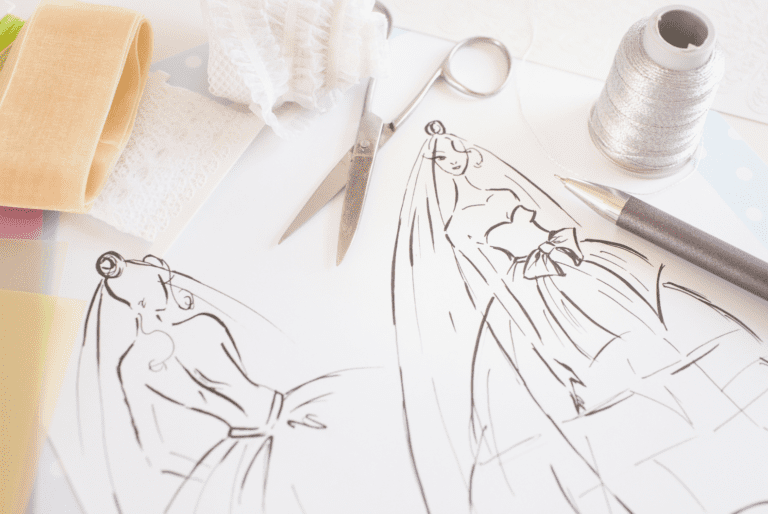THE TRANSLATION OF BRIDAL FASHION BRANDS: STRATEGIES FOR EFFECTIVE GLOBAL COMMUNICATION

In the world of bridal fashion, where every detail counts and each thread weaves stories of love and tradition, the language barrier can be as challenging as choosing the perfect lace for a veil.
As a designer sketches a dress that will embody dreams in Tokyo and New York, the translator weaves a fabric with threads made of words, cultures, context, and creativity.
In this article, we will explore how linguistic precision and cultural sensitivity not only facilitate multilingual and international communication for bridal fashion brands, but actually enrich the creations, allowing designers’ visions to flourish in international markets.
From the unique challenges translators face to the transformative impact of localization, we will uncover the untold stories interwoven in wedding dresses that cross borders and captivate hearts.
Linguistic and Cultural Challenges in Bridal Fashion Translation
One of the most critical aspects of bridal fashion translation is managing terms and concepts that may be endemic to certain cultures and completely unknown in others.
For example, the Korean “hanbok,” a traditional bridal attire, carries not only a specific style and design but also a set of traditions and meanings that can be difficult to convey in languages and cultures that do not have a direct equivalent.
Similarly, terms like “lehenga” in India and “flamenco dress” in Spain refer to specific types of bridal dresses that carry deep cultural and aesthetic connotations.



These challenges are magnified when translators must explain concepts like something old, something new, something borrowed, something blue from Anglo-Saxon tradition to cultures that do not share this custom.
Each element has its symbolism that can be lost or misinterpreted without careful and contextualized explanation.
Another challenge is represented by colors: the color of the wedding dress can vary significantly from one culture to another.
While in many Western cultures white is the standard due to its symbolism of purity and innocence, in countries like China and India, vibrant colors such as red are preferred for their association with good luck and prosperity.
Therefore, the linguist is a true cultural mediator that must ensure that the communication of design and style remains precise and enriches the cultural exchange carried out through bridal fashion collections.
In short, the translator guarantees the balance between accuracy and cultural sensitivity that transcends words and reaches the visual context.
Specific Terminology: When Precision is Everything
The specific terminology is key to facilitating precision and clarity in a sector as detailed and personalized as bridal fashion.
It is the pillar on which interactions between designers, manufacturers, and clients at a global level are built, and a correct translation is vital to maintaining the integrity and original intent of each creation.
For example, technical terms used to describe the types of cuts of a wedding dress—such as “empire cut,” “mermaid cut,” or “princess cut”—must be carefully translated to preserve the design specifications.
A misunderstanding of these terms can lead to errors in the making of the dresses, affecting customer satisfaction and the brands’ reputation.


The language used to describe fabrics and embellishments is equally critical. Terms such as “chantilly,” “organza,” or “illusion tulle” must be handled with precision to ensure that the fabrics used meet the design expectations and requirements.
The difference between “lace” and “brocade,” for example, is significant, and an inaccurate translation can result in a dress that dramatically differs from the desired original design.
Designers and brands looking to expand into international markets must be particularly aware of these linguistic and cultural variations.
Collaborating with a strategic language partner specialized in fashion can help ensure that product communication is clear and effective, avoiding misunderstandings that could be costly and detrimental to the brand’s image.
Global Trends and Localization in Bridal Fashion
In the dynamic world of bridal fashion, global trends and localization are two sides of the same coin.
While major trends may emerge from fashion capitals like Paris or New York, their adoption and adaptation in local markets depend largely on the ability of brands to communicate and localize their products in a way that resonates with local audiences.
This localization process is not simply a matter of linguistic translation but a careful cultural transformation that considers both aesthetics and local traditions.
For instance, a global trend may highlight the use of minimalist silhouettes and sustainable fabrics, but its implementation in different markets may vary considerably.
In Asia designs may need to be adjusted to incorporate traditional elements such as specific embroideries or auspicious colors that are significant in local weddings.
In this context, localization involves a deep understanding of what these elements represent for the target culture and how to integrate them into the design without compromising the global style.
Moreover, the communication of these adapted trends also needs to be culturally tailored.
Marketing materials and brand narrative must be carefully adapted to reflect the language and values of the local market.
This includes adjusting the tone and style of the content to appeal to local target customers.
In markets where weddings are predominantly luxurious and traditional, marketing can focus on the opulence and craftsmanship of the dresses, while in markets more inclined towards minimalism, more linear designs might be emphasized.
CONCLUSION
In conclusion, bridal fashion brands that achieve this synergy between global trends and localization not only expand their market reach but also build deeper and more meaningful relationships with their customers.
At Kosmos Lingua we are experts in localizing and culturally adapting bridal fashion content for premium fashion brands.
From catalogues to marketing campaigns, we have helped our clients thrive in different markets with dedicated teams of specialised fashion and marketing translators and copywriters.
Book a discovery call to know more about how we can help you with your international strategy.
